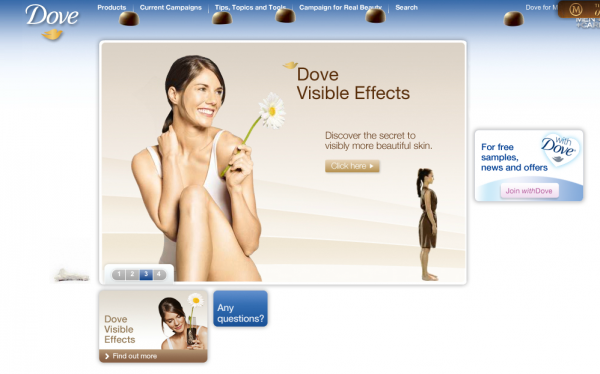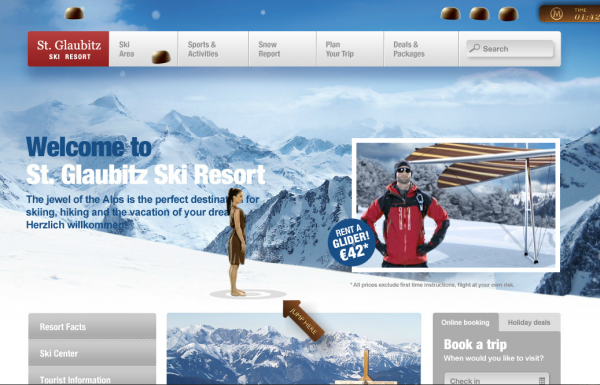von Roland Hachmann | Juli 15, 2011 | Blog, Digital Marketing, Online Advertising
The principle is a simple jump and run game. However in this case, you have to guide the female avatar across a range of well-known sites. From time to time, there are nice animations of the avatar interaction with the site in a surprising way.
Fascinating in terms of selection of sites and interaction with these sites. Not very sticking, though. Once you have visited a few sites, it does get a little boring, since the game play is not very special.
Just wondering: did they really get permission from all those brands to use their site-screenshots in a game? Respect to the account manager arranging all these deals.
Try it yourself: the Magnum Site-to-Site Travel Game.



von Roland Hachmann | Juli 26, 2008 | Blog, Digital Culture, Digital News, Marketing Trends, SEO / SEA
Just a quick note: While read/writeweb writes about information overload and how it has caused a productivity loss of $650 billion, Google boasts about having indexed 1 trillion (1,000,000,000,000) Websites. Add Email, twitter, SMS and possibly even paper producst like books and newspapers, the amount of information available – or battling for our attention – is enormous these days.
Tools for searching (or: finding), aggregation, filtering and blocking will become ever more important.
von Roland Hachmann | März 20, 2008 | Blog, Digital Marketing, Marketing, Online Advertising, SEO / SEA
I usually try not to write negative about things, because unless it’s constructive criticism for the creator of the content, nobody gains much. But since there is no possibility to comment on things at marketingvox, I will do it here.
I am referring to the post with the title „How-to: 9 Basic SEO Tips„. It caught my attention, because just the other day, I had a discussion with colleagues at the agency about how creative agencies rarely know how to properly search engine optimize the websites they build.
However, with the 9 basic tips, we won’t get very far either. Let me quote some of them:
Find out how well you rank online. […] It may be helpful to download the Google Toolbar, which gives you the „PageRank“ score for websites. Pages are scored on a scale of 1 to 10. The goal will be to make this number higher on your website.
Ok – and how? (It doesn’t say). Another great tip:
Submit your site to search engines. Do it personally; avoid „submission services“ or software. You only need to do it once.
I won’t continue with other tips like „place relevant keywords in the title tag“ or „use alt tags on images“ that they also featured.
Was any of this new to anyone? Please ? If so, just leave this blog immediately. In fact – please leave the internet and switch off your computer completely.
Gheez – we’re in 2008 by now, it’s not 1998 any more!
Not sure about the target audience of marketingvox, but for this article, it sure isn’t your average webmarketer!
von Roland Hachmann | Feb. 10, 2008 | Blog, Digital Marketing, Marketing, Online Advertising, Social Media Marketing
Mitch Joel pointed me to a business week article about advertising in social networks. In the same post he also links to a blogpost claiming social media sites need advertising.
In short: time spent on social networks is declining, for whatever reason – one could of course be increased advertising on these platforms. So this could be a problem for advertisers in the near future. Secondly: social networks need advertising, the same way media has always been ad supported.
But it’s not only the fact that user numbers are going down, ads on social networks are also less effective than on regular websites:
Many of the people who hang out on MySpace, Facebook, and other sites pay little to no attention to the ads because they’re more interested in kibitzing with their friends. Social networks have some of the lowest response rates on the Web, advertisers and ad placement firms say. Marketers say as few as 4 in 10,000 people who see their ads on social networking sites click on them, compared with 20 in 10,000 across the Web.
The solution to this is new targeting mechanisms, to serve users more relevant messages.
Last fall, both rolled out programs allowing marketers to pitch products to people in hundreds of categories of interest, such as fashion and sports. News Corp. President Peter Chernin said on Feb. 4 that response rates on MySpace improved as much as 300%.
Could be a solution. But at the end of the day, this whole approach still tries to use old answers to new problems. How about taking an approach that looks beyond plain advertising? How about introducing branded widgets, services, or exclusive whatevers to these platforms, so that brands can provide an added value to the interaction between users?
I am thinking of such things as the Red Bull Rosham Bull Challenge in facebook, which is a game that two users can play against each other. Or even just plain and simple things like the fact that you can sponsor digital gifts in facebook. There still is lots of potential for these kind of approaches.
Oh, and from a business model perspective: I don’t think social networks need advertising support. At least not to the extent that their business models are in danger if there is no proper ad solution in place.
Think about the German platform Xing.com. There you have a choice of paying a monthly premium for additional services – one of which is the fact that you don’t get to see any ads.
There could also be other models, like changing the business model slightly and starting e-commerce around certain product groups (i.e. certain information-based, digital products or even real products).
These problems are not really new. But what this whole discussion shows, is simply the fact that social networks have, all of a sudden, exposed the need for new marketing approaches much clearer than any of the previous developments on the web.
von Roland Hachmann | Juli 24, 2007 | Blog, Digital Culture, Digital Marketing, Digital News, Marketing, Marketing Trends, SEO / SEA, Social Media Marketing
Sean pointed me to an old article that takes us down memory lane. It’s about the gold rush feeling some 12 years ago. The hopes and expectations were as high as today, but the numbers behind „the web“ were much smaller. Here is a couple of quotes, plus my own thoughts of what has changed in the last 12 years.
It’s that huge body of potential consumers that has businesses scrambling to get onto the Web, to which 6.64 million computers are already hooked up. There are more than 100,000 Web sites already […] The popular Yahoo guide to the Web lists more than 23,540 companies. […] Nielsen Media Research (famed for its TV-market analysis) found that 24 million people in the United States and Canada have used the Internet in the past three months–more than 18 million of whom used the Web.
Interesting by the way, the differentiation between the web and the internet. I guess most digital immigrants of today wouldn’t know that there ever was a difference. And I also think that in another 10 years time, people won’t know what we mean by „surfing the internet“ or „being online“. Simply because the net will be omnipresent. Every electronical device and every house, car, fridge, will be connected to the net. People will be online all the time, without thinking or doing anything about it.
To many, this is the dawn of a radical new commercial era in which a single medium combines elements that used to be conveyed separately: text, voice, video, graphics. Countless firms will be transformed in the process, including publishing, banking, retailing and deliverers of health care, insurance and legal services. […] Is there a market for this commercial zeal? Answer: There is a fairly small one now and probably a large one to come in the next decade. But many things must happen technologically and creatively to draw more paying customers.
While the boom up until 2001 was filled with hope in an era of still too few users and static websites, the last couple of years have changed that. This is, of course, what people refer to as web 2.0. It caused a shift, both technologically, and in the way users can interact with websites (i.e. companies). And there is around 1 billion people online by now – in many developed countries, the rate is between 40-70% of the population.
most information on the Internet is already free, as is much software. Experienced Internauts, not used to paying for things they download, may be reluctant to pay as they go. Second, as spectacular as the Web technology is, it still has a considerable way to go to become attractive to the great numbers of consumers who are used to the amenities of mall and catalog culture.
Things like Flash, AJAX, etc. have greatly improved the usability of many sites. Some sites have implemented payed content business models which actually work, based on exclusive content or functionalities. But quite a few sites that tried to offer more or less regular content for paying subcribers did not succeed an opened up their archives again. This will not change. Unfiltered, regular content will become somewhat of a commodity. Only sites offering added value through filtering, remixing, sorting or commenting existing content will make a difference. If, and only if, users can tailor these services to their needs. Relevance of content will be increasingly important during the ongoing flood and fragmentation of information.
The new requirements for advertising and marketing in this new era were already cristal clear in 1995:
Understand the medium. Conducting business on the Web, a phenomenon with no parallel in communications history, will demand new strategies in advertising and marketing. Unlike broadcasting and print, which are one-to-many entities with a passive audience, the Internet is a many-to-many medium in which everyone with a computer and modem is a potential publisher. Web surfers, for example, tend to be self-directed. They typically have little patience for „brochureware,“ advertisements that are thrown up like so many billboards.
The Web gives commerce a unique opportunity to communicate directly with employees and customers around the world. „The Web can be a powerful tool for fostering connections, building associations, delivering information and creating online communities,“ says John December, co-author of The World Wide Web Unleashed. […] The Web, says Hamilton [Federal Express], is „one of the best customer relationship tools ever.“
I wonder, why it has taken the industry so long to start offering the right kind of marketing tools? In a way, there still is a lot of companies out there that don’t respect what has been written 12 years ago!
I am very curious to see what the world will look like in another 12 years. I will be close to 50 years old, probably with kids – digital natives – and hopefully still maintain this blog. Just to make sure that I will pull this old post out again, I will send myself a reminder via email for in 12 years time, using futureme.org.




 Wo ich sonst so bin...
Wo ich sonst so bin...